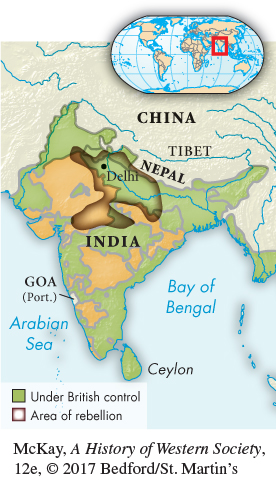A History of Western Society: Printed Page 819
A History of Western Society, Value Edition: Printed Page 786
A History of Western Society, Concise Edition: Printed Page 819
Empire in India

India was the jewel of the British Empire, and no colonial area experienced a more profound British impact. Unlike Japan and China, which maintained a real if precarious independence, and unlike African territories, which Europeans annexed only at the end of the nineteenth century, India was ruled more or less absolutely by Britain for a very long time.
Arriving in India on the heels of the Portuguese in the seventeenth century, the British East India Company had conquered the last independent native state by 1848. The last “traditional” response to European rule — an attempt by the existing ruling classes to drive the invaders out by military force — was broken in India in 1857 and 1858. Those were the years of the Great Rebellion (which the British called a “mutiny”), an insurrection by Muslim and Hindu mercenaries in the British army that spread throughout northern and central India before it was finally crushed, primarily by loyal indigenous troops from southern India. Britain then established direct control until Indian independence was gained in 1947.
India was ruled by the British Parliament in London and administered by a tiny, all-
It is this consciousness of the inherent superiority of the European which has won for us India. However well educated and clever a native may be, and however brave he may prove himself, I believe that no rank we can bestow on him would cause him to be considered an equal of the British officer.12
British women played an important part in the imperial enterprise, especially after the opening of the Suez Canal in 1869 made it much easier for civil servants and businessmen to bring their wives and children with them to India. These British families tended to live in their own separate communities, where they occupied large houses with well-
A small minority of British women — many of them feminists, social reformers, or missionaries, both married and single — sought to go further and shoulder what one historian has called the “white women’s burden” in India.13 These women tried especially to improve the lives of Indian women, both Hindu and Muslim, promoting education and legislation to move them closer to the better conditions they believed Western women had attained. Their greatest success was educating some elite Hindu women who took up the cause of reform.
Inspired by the “civilizing mission” — as well as strong feelings of racial and cultural superiority — British imperialists worked energetically to westernize Indian society. Realizing that they needed well-
This new Indian elite joined British officials and businessmen to promote modern economic development, a second result of British rule. Examples included constructing irrigation projects for agriculture, building the world’s third-
Finally, with a well-
Despite these achievements, the decisive reaction to European rule was the rise of nationalism among the Indian elite. No matter how anglicized and necessary a member of the indigenous educated classes became, he or she could never become the white ruler’s equal. The top jobs, the best clubs, the modern hotels, and even certain railroad compartments were off limits to darker-
By 1885, when educated Indians came together to found the predominantly Hindu Indian National Congress, demands were increasing for the equality and self-